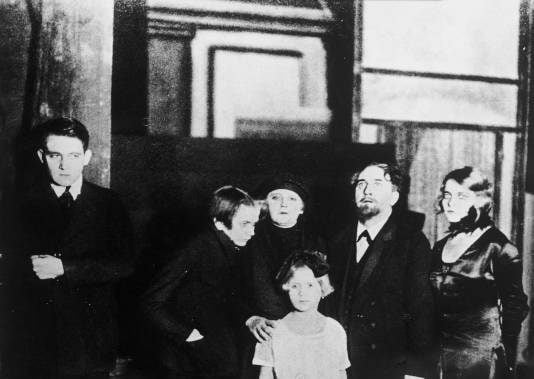By Prof. Levine & Dr. Salganik
Greetings,
This is our 12th conversation.
As we all know, humans are social animals living in families of their own kind [and sometimes even in clans or tribes].
But even these families, be them as extended as they are, are integrated, after all, within a comprehensive and larger social matrix [for example, the country they are staying in]. Although our immediate experience suggests us that the norms of the family surrounding us often determine our attitudes and behavior, we claim that if we examine the matter in depth, it is the norms of the larger social group that often dictate our attitudes and actions and usually prevail over the attitudes and family norms.
Is it therefore true that the norms of the larger social group [whether in our time or in ancient times] generally prevail over the norms of the smaller group? If this is true, then perhaps we can declare a rule that the larger the group, the more its norms dictate the norms and attitudes of smaller groups contained within it.
Even if we accept this rule, it is not always true, especially for separatist, anarchist or avant-garde groups. However, even in these latter groups, alongside the customary attitudes and deviant norms, there are still ruling attitudes and norms of the larger group after these have been filtered by the norms of the deviant group.
We believe that this accepting the social norms of the extended group is critical to the social survival of the extended group and when it is not fulfilled, the extended society may come to disintegration.
So it seems then that there is usually a hierarchy of social groups related to size [but as mentioned this does not always apply to marginal groups], with the largest social group at the top, such as the state for example, whose norms and attitudes are usually dominant relative to those of the smaller groups contained within it. It also seems that we as social animals tend to mark who is the higher group in the hierarchy and conform to its norms even if we are not aware of it.
In other words, it seems that the hierarchical principle is extremely important. Indeed brain findings in humans show that there are brain representations for social hierarchy.
Read more »
By Prof. Levine & Dr. Salganik
שלום רב,
זוהי שיחתנו ה-12.
נפתח ונאמר כי בני האדם הינם חיה חברתית החיים במשפחות לסוגיהן [ולעיתים אף בחמולות או בשבטים].
אך אפילו משפחות אלו, יהיו מורחבות כאשר יהיו, הרי הן נמצאות במטריקס חברתי מקיף וגדול יותר [למשל המדינה בה שוהים]. אמנם בחוויתנו המיידית אנו חווים בדרך כלל כי נורמות המשפחה הן המקיפות אותנו וקובעות לא פעם את עמדותינו והתנהגותנו, אך אנו טוענים כי אם בודקים לעומק את הדבר, הרי נורמות הקבוצה החברתית הגדולה יותר הן שמכתיבות לא פעם את עמדותינו ופעולותינו וגוברות בדרך כלל על העמדות והנורמות המשפחתיות.
האם אפוא נכון הדבר כי הנורמות של הקבוצה החברתית הגדולה יותר [אם בימנו ואם בימי קדם] גוברות בדרך כלל על נורמות הקבוצה הקטנה יותר? אם הדבר נכון הרי שאולי מכאן ניתן לצאת לכלל רחב כי ככל שהקבוצה גדולה יותר הנורמות שלה מכתיבות את הנורמות והעמדות לקבוצות קטנות ממנה המוכלות בתוכה.
אף אם נקבל כלל זה, הרי זה אינו תמיד נכון, והדברים אמורים במיוחד לגבי קבוצות בדלניות, אנרכיסטיות או אוונגרדיות. עם זאת גם בקבוצות אחרונות אלו לצד העמדות המנהגים והנורמות החריגות, קיימות עדיין עמדות ונורמות הקבוצה הגדולה יותר לאחר שאלו עברו סינון על ידי נורמות הקבוצה החריגה.
נציין כי נושא זה של קבלת הנורמות החברתיות של הקבוצה הרחבה הינו קריטי להישרדות החברתית של הקבוצה הרחבה ובשעה שאינו מתקיים החברה הרחבה עלולה להגיע להתפרקות.
נראה אם כן כי בדרך כלל ישנה היררכיה של הקבוצות החברתיות הקשורה בגדלן [אך כאמור אין הדבר תופס לקבוצות חריגות] כשבראש בדרך כלל ניצבת הקבוצה החברתית הגדולה יותר כמו המדינה למשל אשר הנורמות והעמדות שלה בדרך כלל דומיננטיות יחסית לאלו של הקבוצות הקטנות יותר המוכלות בתוכה. נראה גם כי אנו כחיות חברתיות נוטים לסמן מי הקבוצה הגבוהה יותר בהיררכיה ונענים לנורמות שלה אף אם איננו מודעים לכך.
כלומר נראה אפוא כי העקרון ההיררכי חשוב ביותר. אכן ממצאים מוחיים בבני אדם מראים כי קיימים ייצוגים מוחיים להיררכיה חברתית.
Read more »
By Prof. Levine & Dr. Salganik
שש דמויות [או נפשות] מחפשות מחבר הוא מחזה מאת לואיג'י פיראנדלו שנכתב ב 1921 .

לואיג'י פּירַאנְדֶלּוֹ ; (1867 – 1936) סופר ומחזאי איטלקי, זוכה פרס נובל לספרות ב-1934
במחזה המכונה " שש נפשות מחפשות מחבר" להקת תיאטרון עורכת חזרות להצגה, כאשר לפתע מופיעות על הבמה שש דמויות שאינן שייכות להצגה, ומשתלטות על הבמה. אבי המשפחה מספר שהדמויות הן פרי יצירתו של מחבר שחזר בו, וכעת הן רוצות לבוא לידי ביטוי ומבקשות מהבמאי שיציג את סיפורן הטראגי.
בעלילה [ראה ויקיפדיה] האב הוא אדם משכיל רם מעלה, שנשא אישה ממעמד נמוך ממנו. לזוג נולד בן, וכשהבן הגיע לגיל שנתיים, האב עזב את האישה, שידך לה את מזכירו, וגרש אותם. המזכיר והאישה נוסעים לחיות בעיר אחרת, ונולדו להם שלושה ילדים.
לאחר פטירתו של המזכיר האישה ושלושת ילדיה הופכים חסרי כל, ושבים לעיר מגוריו של האב. האם מוצאת עבודה בחנות כובעים. מעל החנות קיים בית בושת בו מעבידה בעלת החנות בזנות נערות עניות, אחת מהן היא בתו החורגת של האב. האב הוא לקוח קבוע במקום, ועומד לשכב עם בתו החורגת בלא לדעת מי היא. האם מגיעה למקום ומפסיקה אותו בזעקות, ממש לפני שהוא עומד לעשות זאת. האב מזועזע מהדבר, ואוסף את המשפחה אל ביתו. האם פוגשת את הבן שהופרד ממנה זה שנים, אך זה מתנכר אליה, והאם מזניחה את ילדיה. האב והבת החורגת מרבים לריב. הבת הקטנה שהוזנחה טובעת בבריכה. אחיה הדיכאוני ממלא פיו מים, ולבסוף מתאבד. בתחילה הבמאי מסרב להציג את הסיפור, אחר-כך מתרצה, ומנסה לעשות זאת, ולבסוף מתייאש.

Six Characters in Search of an Author: Mathias Wiemann (left), Lucie Hoeflich (centre), Franziska Kinz (right), 1924 staging at the Deutsches Theatre in Berlin, directed by Max Reinhardt
שחקני ההצגה שהוצגה בברלין ב-1924 בבימויו של מקס ריינהרט.
משמעויות שונות ניתנו למחזה. כך למשל כתב בעבר איתן בר יוסף, ב"עכבר העיר" במרץ 2010 כי "משמעותו של המחזה…. בערעור הגבולות בין מעשה היצירה ובין המציאות… בעיצומה של חזרה על המחזה נכנסות אל הבמה כמה דמויות – אבא, אם, בת, בן, נער וילדה קטנה. מתברר, שהמחבר, שברא אותן, נעלם לבלי שוב; איש אינו יודע מדוע ולאן. על הדמויות המיותמות נגזר עתה לנדוד בעולם, לכודות בהווה קיומן שאין ממנו מפלט, משוועות ליוצר שיממש את סיפורן על הבמה….
Read more »
By Prof. Levine & Dr. Salganik
Greetings to you all,
We are in our eleventh conversation.
We will open this in reminding that the human brain is designed to recognize faces of human figures. It also seems that the brain is tailored to represent diverse phenomena that as if they were human characters.
Clues to this can be found, for example, in representations of natural phenomena as characters in human mythology [used and written by humans]. The natural phenomena such as wind, rain, lightning, and the sea are represented by figures of gods.
We also hold that within us, in our souls, the social "self" is represented by a "jury" or "board" of internalized figures.
These internal figures, most of which are internalizations of influential figures in external reality, are shaped during life, and sometimes following a crisis or trauma or events related to that figure [or alternatively during a significant development such as creating a new meaning for life and re-evaluating positions], there may even be several versions of that figure during the life.
This is how it is possible to internalize various external figures that influence the person, but the most important internal internalization is that what we will call the “Dictator-Self”. It is all about internalizing a character that has a great influence and shapes the person for good and/or bad, that has a great influence on the board of internal characters that build the social "self". We assume this “internal dictator” to have a decisive role and a profound influence on the internalization of external figures (or in professional language – external objects]. Its attitudes play a major role in taking decision whether internalization is to be rejected or, if accepted, in what form is it going to prevail.
In other words, in a certain sense, we assume that this influential figure is also a kind of internal censor. It should be emphasized that we are not talking or conjecturing concretely about the presence of figures in the inner world as a sort of “little people ” in our brain but about their representations whose nature and manner of representation in the brain still requires research. We will also note that although we call this figure a "dictator", except for a certain type, it’s characteristics are not the same as that of a dictatorial ruler over a certain country, but rather that this figure is dominant and influential within the inner "directorate".
Read more »
By Prof. Levine & Dr. Salganik
שלום רב,
אנו בשיחתנו האחת עשר.
נפתח הפעם ונזכיר כי המוח בנוי לזיהוי פנים, פנים של דמויות אנוש. נראה גם כי המוח מחוייט לייצג תופעות מגוונות שהינן אנושיות כדמויות.
רמזים לכך ניתן למצוא למשל בייצוגי תופעות טבע כדמויות במיתולוגיה האנושית [שנהגתה ונכתבה בידי בני אנוש]. כך תופעות טבע כרוח, גשם, ברק, וים מיוצגות על ידי דמויות של אלים.
אנו גורסים גם כי בתוכנו פנימה, בנפשנו, ה"עצמי" החברתי מיוצג על ידי "חבר מושבעים" או "דירקטוריון" של דמויות מופנמות.
הדמויות הפנימיות הללו שברובן הינן הפנמות של דמויות משפיעות במציאות החיצונית מעוצבות במשך החיים, ולעתים בעקבות משבר או טראומה או אירועים הקשורים באותה דמות [או לחלופין בעת התפתחות משמעותית כמו יצירת משמעות חדשה לחיים והערכה מחדש של עמדות], יתכנו במהלך החיים אף גרסאות מספר של אותה דמות.
כך ניתן להפנים דמויות חיצוניות שונות המשפיעות על האדם, אך ההפנמה הפנימית החשובה ביותר, הינה זו של מה שנכנה "הדיקטטור" העצמי. כאן מדובר על הפנמת דמות בעלת השפעה גדולה ומעצבת על האדם לטובה ו/או לרעה, שלה השפעה גדולה על דירקטוריון הדמויות הפנימיות הבונות את ה"עצמי" החברתי. לדיקטטור פנימי זה אנו מניחים תפקיד מכריע והשפעה עמוקה על הפנמת דמויות חיצוניות [או בלשון מקצועית אובייקטים חיצוניים]. עמדותיו של הדיקטטור ממלאות תפקיד מרכזי בקבלת החלטות אודות הפנמות של דמויות. הוא מחליט האם יש לדחות את ההפנמה או, אם תתקבל, באיזו צורה היא תופנם. במילים אחרות במובן מסוים אנו מניחים כי דמות משפיעה זו הינה גם כמעין צנזור פנימי. יש להדגיש כי אין אנו מדברים או משערים קונקרטית על נוכחות דמויות בעולם הפנימי כמעין אנשים קטנים אלא בייצוגים שלהן שטיבם ואפן ייצוגם במוח דורש עדיין מחקר. כמו כן נציין שאומנם אנו קוראים לדמות זו "דיקטטור" אך להוציא סוג מסוים אין מאפייניו זהים לזה של שליט דיקטטורי על מדינה מסוימת, אלא שדמות זו הינה דומיננטית ומשפיעה בקרב "דירקטוריון הדמויות".
Read more »
 Prof. Joseph Levine, M.D. is an emeritus associate professor in the Division of Psychiatry, Faculty of Health Sciences, Ben Gurion University in Israel. Prof. Levine is a certified psychiatrist with clinical experience in controlled trials of adult psychiatric disorders and in psychotherapy. He was awarded a NRSAD independent investigator grant for the study of Creatine Monohydrate in psychiatric disorders -- mainly Schizophrenia. He resides and treats patients in Tel Aviv and all of central Israel.
Prof. Joseph Levine, M.D. is an emeritus associate professor in the Division of Psychiatry, Faculty of Health Sciences, Ben Gurion University in Israel. Prof. Levine is a certified psychiatrist with clinical experience in controlled trials of adult psychiatric disorders and in psychotherapy. He was awarded a NRSAD independent investigator grant for the study of Creatine Monohydrate in psychiatric disorders -- mainly Schizophrenia. He resides and treats patients in Tel Aviv and all of central Israel.

